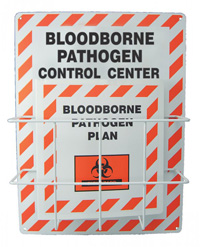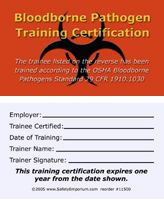



Find all of your laboratory and workplace safety supplies at Safety Emporium!
 Cyanosis |
 Glossary Index |
 Decomposition |
| MSDS Topics |
Free Sites | FAQ's | Regulations | Glossary | Software | Suppliers |
| Books | Forum | Poll | Fun stuff | Quiz | Store | |
| Understand your MSDS with the MS-Demystifier | Search ALL our MSDS info | |||||
A cytotoxin (noun) has a direct toxic or destructive effect on certain cells of the body (usually those of a particular organ). Specific examples include nephrotoxins which damage the kidneys and neurotoxins which damage the nervous system and brain.
Cytotoxic (adjective) relates to cytotoxins and/or their their effects. For example, a "cyctotoxic drug".

Safety Emporium carries bloodborne pathogen compliance centers and related compliance materials.
Many cancer treatments use cytotoxins to kill cancer cells. Cancer cells, by definition, rapidly divide compared to the normal cells in your body. If a doctor administers a cytotoxin, these cancerous cells will die at a much faster rate than the normal cells in your body. If the cancer cells reproduce at just the right rate, and the dose of the anti-neoplastic agent is correctly balanced, a cancer can be beaten without causing too much additional harm to the patient.
An unfortunate side effect of such chemotherapy is that certain healthy and normal cells in the body such as hair follicles and bone marrow normally reproduce at a rapid rate and therefore suffer significant damage from the cytotoxic anti-cancer agent. This is why many people lose their hair or experience impaired immune systems while on chemotherapy. It is also one reason health practitioners must follow strict personal protection protocols to avoid accidental exposure during administration of chemotherapy drugs (another reason is that many chemotherapy drugs are, ironically, themselves carcinogenic).
Cytotoxins are also produced through various disease processes. For example, gas gangrene, diphtheria, and scarlet fever all produce cytotoxins that worsen the effects of the disease.
NOTE: We may collect a share of sales or other compensation from the links in the following list:
The Safety Data Sheet of a substance with cytotoxic hazards should list this under Section 2 (Hazard(s) identifications) as well as Section 11 (toxicological information). Other sections of the SDS will tell you how to protect yourself with PPE, proper storage, spill procedures and more.
Avoid all use and contact with cytoxic agents whenever possible. If you must use them, use engineering controls such as a fume hood, biological safety cabinet, or cytotoxic cabinet. Always use proper personal protective equipment such as gloves and lab coats. If you are administering cytotoxic drugs to a patient, be sure you are in full compliance with the OSHA Bloodborne Pathogens Standard, 1910.1030 and other appropriate regulations, policies or procedures. Best practice guidelines for practitioners is provided under Further Reading below.

Get your bloodborne pathogen safety materials from Safety Emporium.
See also: carcinogen, carcinoma, malignant.
Additional definitions from Google and OneLook.
Entry last updated: Saturday, July 9, 2022. This page is copyright 2000-2025 by ILPI. Unauthorized duplication or posting on other web sites is expressly prohibited. Send suggestions, comments, and new entry desires (include the URL if applicable) to us by email.
Disclaimer: The information contained herein is believed to be true and accurate, however ILPI makes no guarantees concerning the veracity of any statement. Use of any information on this page is at the reader's own risk. ILPI strongly encourages the reader to consult the appropriate local, state and federal agencies concerning the matters discussed herein.